| |
| |
| |
|
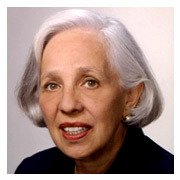
Maxine Frank Singer '52, H'78, a microbiologist and leader in science education, received the Public Welfare Medal from the National Academy of Sciences (NAS) on Apr. 29, 2007. A past recipient of the National Medal of Science, she served as president of the Carnegie Institution of Washington until her retirement in 2003. Learn more in this interview.
|
|
|
| |
This essay first appeared in The Meaning of Swarthmore (2004).
 owadays, diversity in the Swarthmore student body is considered to be an essential component of a good education. And yet the Swarthmore I knew in our years was, in its own way, amazingly diverse. You wouldn't know it from looking at our yearbook photos, where all the women are wearing sweaters with pearls; and all the men, ties and jackets. In fact, the range of talents, interests, and outlooks was enormous. owadays, diversity in the Swarthmore student body is considered to be an essential component of a good education. And yet the Swarthmore I knew in our years was, in its own way, amazingly diverse. You wouldn't know it from looking at our yearbook photos, where all the women are wearing sweaters with pearls; and all the men, ties and jackets. In fact, the range of talents, interests, and outlooks was enormous.
Diversity is, in a very real sense, my business. I evolved from a chemist to a geneticist - of the molecular variety. The study of genetics deals with genes, chromosomes, and DNA molecules, the source of biological diversity. This science, which has advanced so dramatically in the last 50 years, can predict the color of our eyes, hair, and skin pretty well. It can tell us about our inheritance of certain diseases. However, it still can't explain why individuals in our species have such different talents and outlooks. It may well succeed in the future, but for now, the traces of cultural inheritance are more apparent than those of our biological inheritance. At Swarthmore, I inherited values and inclinations that complemented the biological inheritance and other cultural foundations that I had brought with me to the College from Brooklyn, where I went to one of those legendary, huge New York public schools that computed student averages to the fourth decimal place. Most significantly, the Swarthmore experience prepared me to join the scientific community and sustained me in that community through these long, and never easy, years.
How was it that in the 1950 Swarthmore environment, with its American middle-class roots, its deep ties to a religious tradition, and commitment to a liberal education - in the classical meaning of that term - a young person could acquire the culture of modern science? How could this civil place impart the iconoclastic skepticism, the will and skill to challenge received wisdom that are essential to the scientific enterprise? More to the point, how could this happen to a young woman at a time when the scientific community was hardly congenial to female participants?
The answers to these questions are partly general and partly specific.
For the general, two aspects of life at Swarthmore were important for the nurturing of a young scientist: freedom and optimism. For most of us, Swarthmore meant our first freedom from family, from the communities of our childhoods. It also meant the first real intellectual freedom to think on our own. And we all quickly learned that to share thoughts meant subjecting them to criticism.
| |
| |
|
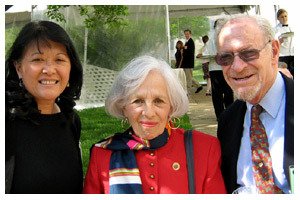
Swarthmore biology professor Amy Cheng Vollmer (left) attended the NAS ceremony and describes Singer as "a terrific role model."
|
|
|
| |
Politically, Swarthmore provided an island of freedom as well, although outside the campus the ugliness of the McCarthy era was under way. Freedom of conscience, a completely new notion for me at the time, was made a reality by fellow students who, as conscientious objectors, went to jail for failure to register for the draft. Such freedoms relate only indirectly to science, but the experience of freedom is essential to the scientific venture. And for a young woman of that era, for whom traditional restrictions and expectations countered the spirit of a free mind, even the inevitably imperfect vision of freedom was critical.
Optimism can follow on freedom, but it also requires a level of self-confidence. It is not enough to think that "it can be done"; it is also necessary to believe that "I can do it." The path, even at Swarthmore, was not smooth. In the required freshman course in philosophy, I loved listening to Sidney Morganbesser talk - his New York accent was a piece of home - but I didn't have the vaguest idea what he was talking about. I had never heard the word "philosophy" until I got to Swarthmore. I was amazed that some of my classmates had not only heard of it, but could discuss philosophers and their viewpoints with apparent intelligence. It dawned on me then that to go from the "I think I can" stage to the more optimistic "I can do it" stage requires a certain level of arrogance. I began to recognize that arrogance can play a constructive role in scholarship. Competition presents related quandaries. It's only a small slide from "I can do it" to "I can do it sooner and better than anyone else." Competitiveness, like arrogance, is not always attractive, but both often motivate good science.
That's the general component of the answer to the questions I posed. What about the specific component?
| |
| |
|
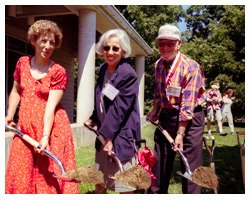
In 2001, Singer, flanked by daughter Amy '82 and husband Dan '51, helped break ground for the College's new science center, which now houses a laboratory given in her honor by her family.
|
|
|
| |
In our class, the core group of serious and gifted science students was overwhelmingly made up of women - we would have said "girls." Six of us in particular were friends. We were colleagues. We were competitors. We talked. We fought. We borrowed sweaters and ideas from one another. We lived together in shifting combinations as roommates in the same dormitories. In the preceding and following classes, there were other scientifically inclined women who figured importantly in our seminars. The men in our science and math classes were themselves wonderfully talented, but there was never any reason to assume that the men were more important to the highly interactive student group, or to the professors, than were the women. And, as the four years progressed, and the classes and seminars became smaller and more advanced, the women predominated. There was not, for us, as there apparently was for so many young women of our era, any reason not to take ourselves and each other seriously. No one told us that we were unlikely. No one told us that we couldn't do what we all dreamed of doing. The invisible walls around the campus shielded us from the fact, which most people knew and we were to learn, that there was little space in the outside world for women as scientists.
It was this core of students that really educated me. Within the group, self-doubts and feelings of inadequacy might prevail, but thanks to the group, the rest of the world began to seem manageable. No doubt, we seemed odd and arrogant to some of our fellow students, which I regret, but any arrogance we displayed was not intended.
I can't say the same for professors. There was one seminar whose membership was mainly from the core. The professor seemed oblivious to the rapidly changing paradigms in biology. Alone, I, a chemistry major, would also have been oblivious, but the others taught me. Each week, the professor laid out topics and reading lists for the next meeting. Immediately after, we all met to change the agenda, make individual assignments, and help one another find the right papers. It was an extraordinarily rich seminar and for me a determinative one. Until then, traditional biology had seemed a sea of unstructured, if interesting, observations. That seminar introduced me to the possibilities of biological chemistry for helping make sense of the vast, complex, and diverse world of living things.
| |
| |
|
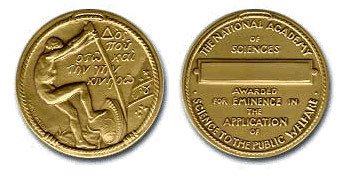
Singer was recognized for providing inspired and effective leadership in matters of science and its relationship to education and public policy. She is the fifth woman to receive the Public Welfare Medal (above) in the award's 93-year history. |
|
|
| |
Was our confidence simply the construction of ambitious young women? No, not at all. The first evidence came our senior year. Sue Carver '52, who became a successful cardiologist, was accepted into a great medical school, even though she ruined her chances at another by telling her interviewer that his questions about her plans for marriage and family were out of order; that took guts in the spring of 1952. The other five went on to graduate school - and with National Science Foundation fellowships. That was the first year such fellowships were available. Six hundred were awarded nationwide; 32 of them went to women; five of those women were members of the Swarthmore Class of '52; a sixth, Rada Demerec, was in the Class of '51. Some of us were fortunate enough to find ourselves in graduate departments that were hospitable. Others encountered more typical troubles from their male professors. One way or another, we prevailed. We did all the things we weren't supposed to do, as well as those we were: We got degrees, we worked, we broke new ground, we published, we married, we had children. Joan Berkowitz '52, an inorganic chemist, built her own successful company in the field of hazardous-waste removal. Laura Maurer Roth '52 became a professor of physics; Vivianne Thimann Nachmias '52, a professor of cell biology. Barbara Wolff Searle '52 went back to mathematics and wound up working on education all over the world for the World Bank.
Swarthmore has been and remains a place where young women can get an extraordinary start in science. Swarthmore graduates, older and younger than we, have made important contributions to the modern understanding of the natural world. It is a marvelous surprise each time I encounter one of them. Astronomers like Nancy Grace Roman '46 and Sandy Moore Faber '66; biologists like Jane Kellock Setlow '40 and Carolyn Walch Slayman '58; professor of linguistics Barbara Hall Partee '61; seismologist Ines Cifuentes '75, who became my colleague in the Carnegie Institution's efforts to train elementary school teachers in Washington, D.C., to teach science effectively.
All these women have been able to contribute to the incredible scientific discoveries of the past decades. Swarthmore made it possible. And in doing that, it has played a critical role in advancing freedom and optimism for all. It is a role to celebrate!
Swarthmore's excellence in educating future scientists continues. In 2005, Tafadzwa Muguwe '05 became the the third science major since 2000 to be named a Rhodes Scholar. Learn more about science education at the College in this article from the alumni magazine.
|
|
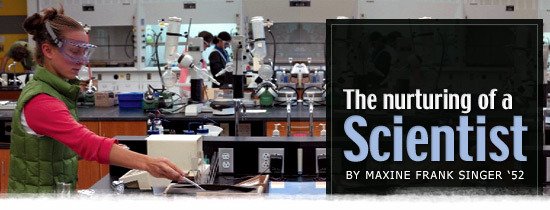
 owadays, diversity in the Swarthmore student body is considered to be an essential component of a good education. And yet the Swarthmore I knew in our years was, in its own way, amazingly diverse. You wouldn't know it from looking at our yearbook photos, where all the women are wearing sweaters with pearls; and all the men, ties and jackets. In fact, the range of talents, interests, and outlooks was enormous.
owadays, diversity in the Swarthmore student body is considered to be an essential component of a good education. And yet the Swarthmore I knew in our years was, in its own way, amazingly diverse. You wouldn't know it from looking at our yearbook photos, where all the women are wearing sweaters with pearls; and all the men, ties and jackets. In fact, the range of talents, interests, and outlooks was enormous.





